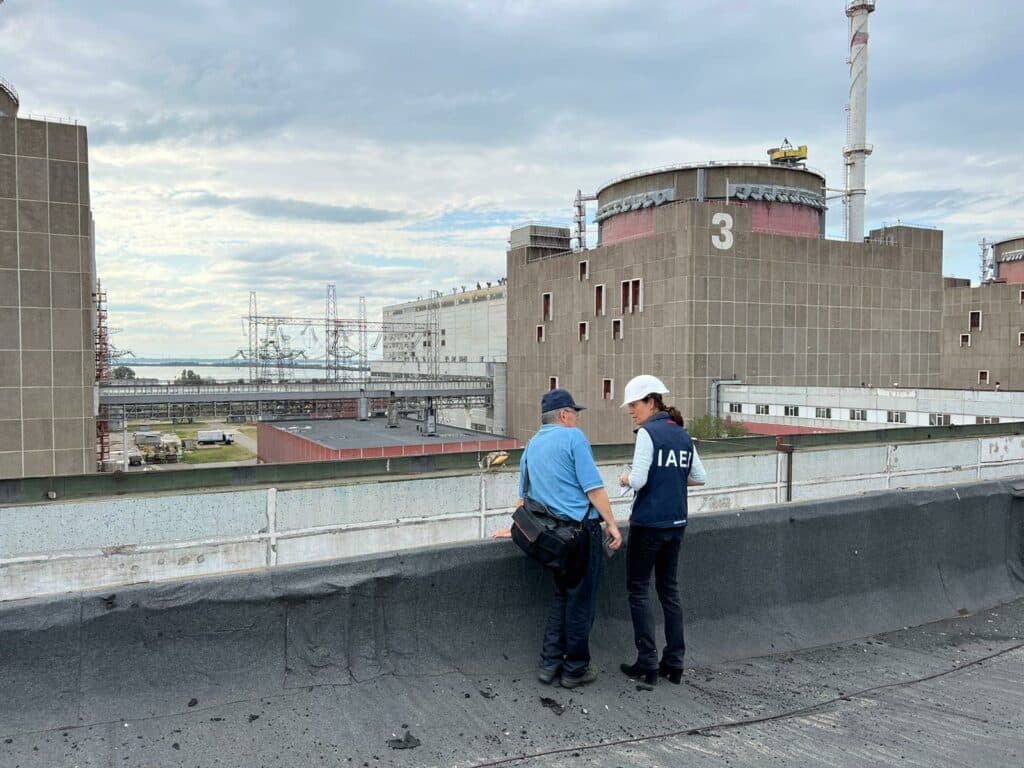[ad_1]

The Russian military enters Chernobyl, forcing the plant’s managers to work weak, multi-day shifts and their lives under threat. The Romanian government allocates millions of dollars to quickly produce anti-radiation iodine pills. Sales of single-family homes will increase. This is not 1986; It’s 2022. Russia’s massive invasion of Ukraine has brought back Cold War concerns, not least the return of nuclear fear and the threat of nuclear accidents.
Since early March, Russian forces have bombed the Zaporizhzhia nuclear plant in southern Ukraine, the largest plant in Europe and the tenth largest in the world. Russia’s actions in Zaporizhzhia set a bad example. To prevent other countries from similarly targeting and attacking nuclear facilities in future wars, the international community needs to improve existing guidelines for physical protection.
The current international nuclear safeguards regime focuses on safeguards against those who attempt the unauthorized acquisition of nuclear materials or engage in countermeasures. Efforts to reduce the risks for terrorists and those familiar with nuclear plants are front and center in these discussions. But Russia’s actions show the limits of this approach when nuclear facilities are located in a war zone. These laws do little to prevent government forces from operating illegally in and around nuclear plants.
The Russian military attacks on Ukraine’s nuclear plants highlight the need for comprehensive guidelines for the physical protection of nuclear facilities.

The bad example of Russia. Russia’s presence at the Zaporizhzhia nuclear facility increases the risk of power outages and human or military errors. For example, on August 25th, operators disconnected the plant from the power grid for the first time in 40 years. automatic shutdown of both reactors. There was little fighting in Zaporizhzhia and almost since Russia took control of the plant. But the consequences of other military actions on the ground can be normal and widespread. A nuclear accident at the plant—in one or more of its six reactors or spent fuel storage pools—would result in a massive release of radioactive material affecting countries beyond Ukraine’s borders and back many of the dangerous challenges the region has faced since then. the Chernobyl nuclear disaster in 1986.
Radioactive fallout and environmental and agricultural impacts following a nuclear accident will affect populations across Europe, not just the armed forces in Ukraine. The situation at the Zaporizhzhia nuclear plant is a reminder of the broad and pervasive nature of the current nuclear crisis; it also shows that killing nuclear reactors creates a new type of danger. The potential strategic benefits of having a nuclear power plant would be rendered meaningless in the event of a major disaster.
While it seems unlikely that Russia will cooperate on reforming nuclear security and security measures, President Vladimir Putin has signaled his willingness to re-engage with the United States on arms control. It is a great opportunity for the international community to demand that the rules for the safety of nuclear facilities during war be included in such discussions.
Inadequate containment zones. With its relentless war in Ukraine, Russia has violated various international laws and used illegal and ambiguous methods and rules. In order to move forward, the safety and security of nuclear facilities must be strengthened to avoid situations similar to Zaporizhzhia.
There have been two major events in recent years that have reduced the protection of nuclear facilities in relation to security threats. But these laws did little to prevent Russian attacks on Ukrainian nuclear power plants. The IAEA Convention on the Physical Protection of Nuclear Materials and Nuclear Weapons criminalizes crimes related to illicit trafficking and destruction of nuclear weapons and nuclear facilities. But this event does not cover attacks on nuclear plants by government forces. Instead, it focuses on the risks of infiltration that may come from insider terrorists or terrorist organizations. Although the guidelines, which prevent damage to a nuclear facility, are useful in the context of the state and the government, there is no legal procedure to be used in this way.
Likewise, the Geneva Conventions of 1949 established international legal standards for the conduct of war. Article 56 of Protocol I to these provisions states that “nuclear power generating stations” shall not be the target of military attacks. The only exception is where a nuclear facility “provides permanent, substantial, and direct support for military operations, and these attacks are the only possible way to end it.” support.” It raises questions about safeguards for nuclear power generation in military facilities, even as attacks on such reactors continue to harm civilians in many countries. Furthermore, while direct attacks on nuclear power plants that produce power for civilians cannot be considered military targets, they can still be unlawfully destroyed if they are close to a more legitimate military target. . The Geneva Conventions allow the military to destroy so-called “civilian property”—such as power plants, homes, and infrastructure—if this destruction appears to be time-consuming. a soldier attacks an illegal target, such as an enemy military base. In addition, the assemblies do not protect nuclear fuel storage facilities and oil processing facilities, which, if attacked, would cause serious problems and cause a lot of contamination. There is also little scope for violating the Geneva Conventions.
These laws have not been sufficient to prevent or address Russian attacks on nuclear power plants. However, Russia’s actions in Ukraine have invalidated the Geneva Conventions’ restrictions on attacking nuclear facilities. If Russia does not face consequences for its actions, other countries may do better to emulate its behavior.
Many countries have nuclear power plants where there are ongoing conflicts, international security threats, and civil unrest. These include China, Egypt, Taiwan, India and Pakistan. Other vulnerable countries—such as Sudan, Turkey, Libya, and Venezuela—are pursuing or have seriously considered nuclear programs. Without adequate safeguards, current and future nuclear facilities represent major threats to the world, should wars break out against them.
Improve legal protections. There is a growing need to create a system to protect nuclear facilities. This provision should provide protection regardless of how the energy produced by nuclear plants is used—whether for civilian or military purposes—and regardless of the type of facility where the nuclear material is located. In 2019, the IAEA General Assembly recognized a ban on armed attacks and threats to nuclear facilities, although little progress has been made since then. Russia’s actions in Ukraine are a call to speed up these efforts.
The current nuclear defense mechanism could be improved by amending the Treaty on the Non-Proliferation of Nuclear Weapons (NPT) so that it includes language that prohibits the military from targeting facilities nuclear—defined under all conditions. Regulations should also be passed to maintain the safety of nuclear facilities if they change hands after changes in territorial control. These rules allow the International Atomic Energy Agency to inspect nuclear installations on occupied territories, requiring countries to adhere to IAEA guidelines on the duration of the move, personnel treatment, reporting procedures, and other protections.
This approach could strengthen the NPT, impose restrictions on the behavior of international actors, and use a forum with its own inspection mechanism (the IAEA) and accountability mechanisms (sanctions mechanism). .
However, any changes to existing protections will go above and beyond. In August, Russia blocked the adoption of the outcome document of the 10th Review Conference of the Parties to the NPT, saying it intended to include language indicating concerns about security issues. nuclear in Zaporizhzhia.
Russia’s invasion of Ukraine is not the first conflict involving two countries with nuclear installations. But, despite the problems, India and Pakistan have created legal safeguards for their nuclear facilities in the event of war. In 1988, the two foreign secretaries signed the India-Pakistan Non-Aggression Pact, which prohibits “conduct, incitement or participation in any act aimed at the destruction, or to the damage of a nuclear installation in each country.” The Indo-Pakistani treaty on nuclear risk management is an example of laws that promote the physical protection of nuclear facilities. This treaty allows a- second to provide a plan for the way forward by including his language banning indirect attacks on nuclear facilities in many states in the future.
Revise the method. Russia’s attacks on the Zaporizhzhia nuclear facility set a bad precedent. An accident at a nuclear power plant can have serious environmental consequences. The shielding and protection of nuclear power plants is a starting point. Like the Bulletin as recently announced, the destruction of industrial and power plants—whether due to climate change or war—will have a devastating effect on the entire world.
A legal ban on targeting or attacking nuclear power plants could prevent future attacks. Clear standards would prevent the remediation of these attacks, by denying countries the ability to enforce their strict measures. Putin, for example, asserted the legitimacy of his actions in Ukraine, using the lack of laws to his advantage.
Putting in place new laws and regulations to protect nuclear facilities alone will not automatically trigger an alarm. But this type of work is strictly prohibited. Introduction of resistance to one The attack—right or wrong—reduces some of the issues related to the Geneva Conventions on nuclear damage, and emphasizes the importance of avoiding nuclear accidents, even if benefits are in play.
[ad_2]
Source link
